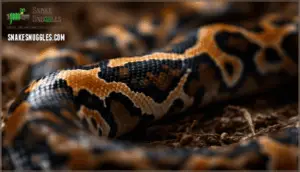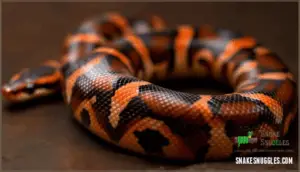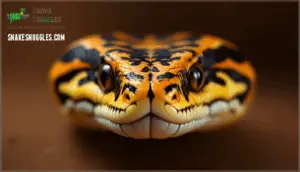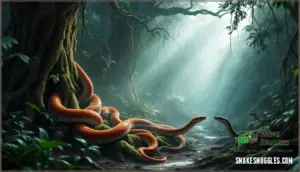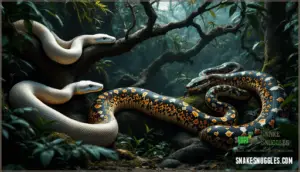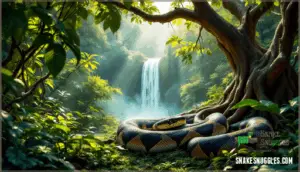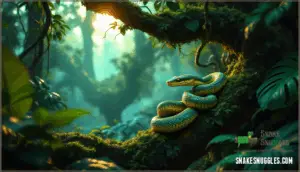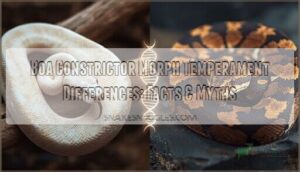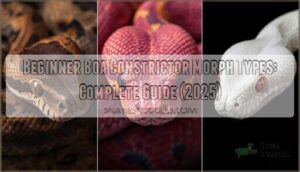This site is supported by our readers. We may earn a commission, at no cost to you, if you purchase through links.

Some populations adapted silvery hues to blend with Argentine scrublands. Others developed deep crimson tails beneath Amazonian canopies.
Captive breeding pushed these variations further, isolating recessive traits into albinos, ghosts, and designer morphs that nature never intended. Understanding these color types means recognizing the interplay between wild ancestry and human selection—and knowing which patterns reveal true subspecies versus laboratory creations.
Table Of Contents
- Key Takeaways
- Common Boa Constrictor Color Patterns
- Color Differences Among Boa Subspecies
- Genetic Morphs and Color Variations
- Environmental Influence on Boa Colors
- Rare and Endangered Boa Colorations
- Frequently Asked Questions (FAQs)
- Do boa constrictors change color as they age?
- Can diet affect a boas coloration?
- Are albino boa constrictors found in nature?
- How do seasonal changes affect boa colors?
- Do male and female boas have different colorations?
- How do boa colors change with age?
- Do male and female boas differ in color?
- What causes color fading in captive boas?
- How to enhance a boas natural colors?
- Conclusion
Key Takeaways
- Boa constrictor colors reflect evolutionary adaptations shaped by geographic isolation, with subspecies like the Argentine boa displaying silvery-gray tones for temperate grasslands while Amazonian populations evolved deep crimson tails for rainforest camouflage.
- Wild coloration serves survival through disruptive patterns and counter-shading, but captive breeding has isolated recessive traits into morphs like albino, ghost, and eclipse that would never survive natural selection pressures.
- Subspecies identification relies on tail band color genetics and head markings more than body saddles, with true Boa constrictor constrictor showing deep brick-red tail bands versus the orange-brown fading seen in Boa imperator.
- Several boa subspecies face extinction with their unique colorations—B. c. occidentalis (CITES Appendix I) and B. c. orophias represent irreplaceable color genetics that conservation breeding programs now struggle to preserve before habitat destruction eliminates them.
Common Boa Constrictor Color Patterns
When you study a boa constrictor, you’re looking at one of nature’s most recognizable patterns. The base coloration and markings serve both camouflage and identification purposes across different populations.
Your understanding of these standard patterns will help you distinguish subspecies and appreciate the genetic variations that follow.
Hourglass-Shaped Saddle Markings
The signature dark-brown hourglass saddles running down a boa’s back aren’t just decorative—they’re your first clue to identifying what you’re looking at.
These saddle patterns vary in four key ways:
- Color intensity shifts from deep chocolate to pale brown depending on genetics
- Shape genetics determine whether saddles appear compressed or elongated
- Marking variations include crisp borders versus blurred edges
- Dark saddles may fragment or fuse in pattern morphs
Understanding these Boa Constrictor characteristics gives you control over identifying subspecies and color morphs before examining tail bands.
Reddish Bands Toward The Tail
Once you move past those saddles, the tail’s reddish bands become your visual proof of whether you’re managing a true Boa constrictor or one of its close relatives. Tail Color Patterns and Red Band Genetics separate true Red-Tailed Boas from Boa imperator specimens through distinct Color Band Variations.
| Subspecies | Tail Band Color | Pattern Intensity |
|---|---|---|
| B. c. constrictor | Deep brick-red | High contrast |
| B. c. imperator | Orange-brown | Moderate fading |
| B. c. longicauda | Black-gold bands | Sharp definition |
| B. c. occidentalis | Pale rust | Low contrast |
Tail Pattern Inheritance in Boa Constrictor Morphs determines whether offspring express vibrant crimson bands or muted tones—critical knowledge for understanding Snake Color and Pattern Variation in captive breeding programs.
Head and Facial Color Variations
Your boa’s head tells a story written in stripes, eye lines, and jaw markings that field herpetologists use to nail down subspecies identification faster than any tail color ever could. Facial Patterns include dark eye stripes extending across temporal scales, while Nose Pigmentation ranges from pale cream in B. c. orophias to dark brown in B. c. constrictor.
Eye Markings and Scale Variations reveal Color Mutation influences in captive Boa Constrictor Morphs—critical markers for understanding Snake Color and Pattern Variation beyond simple body saddles.
Color Differences Among Boa Subspecies
Each boa subspecies carries its own color signature, shaped by geography and genetics. You’ll notice stark differences between South American red-tails and their Central American cousins. Here’s what sets each subspecies apart visually.
Boa Constrictor Constrictor (Red-Tailed)
The true red-tailed boa—Boa constrictor constrictor—lives east of the Andes Mountains in South America, where its namesake crimson tail bands distinguish it from every other subspecies. You’ll find these Redtailed Boa specimens displaying sturdy bodies with brown or tan backgrounds overlaid by dark saddle markings.
Their Snake Habitat ranges from tropical rainforests to drier woodlands. Red Tailed Care requires understanding Constrictor Behavior patterns specific to this Boa Constrictor Subspecies, which differs markedly from Boa Constrictor Morphs bred in captivity for Boa Conservation programs.
Boa Constrictor Imperator (Central American)
West of the Andes, Boa constrictor imperator—often mislabeled as a "red-tailed boa"—dominates Central American territories with a slimmer profile and more subdued tail coloration than its South American cousin. You’ll recognize this Boa imperator subspecies by its docile temperament and average 5-7 foot length, making Imperator Care less demanding than larger Boidae.
Central American Morphs thrive in Boa Breeding programs, where Color Genetics produce sought-after variations within this adaptable snake lineage across diverse Imperator Habitat zones.
Boa Constrictor Longicauda (Peruvian Long-Tailed)
Northern Peru’s montane regions harbor Boa constrictor longicauda, a striking subspecies distinguished by its elongated tail and dramatic black-and-white or black-and-gold patterning that sets it apart from all other boa lineages. Peruvian Habitat conditions shaped this rare Boa constrictor species through geographic isolation, producing unique Snake Morphology traits rarely seen in reptile breeding programs.
- Extended tail length exceeds standard Boa Constrictor Morphs and Genetics proportions
- Contrasting Tail Coloration displays bold monochromatic bands
- Geographic Distribution restricted to Northern Peru’s elevation zones
- Longicauda Care demands specialized temperature gradients
- Wild snake morphs remain scarce in captivity collections
Boa Constrictor Occidentalis (Argentine Boa)
Argentina’s temperate grasslands and dry forests are home to Boa constrictor occidentalis, one of the largest and most visually striking boa subspecies. This cold-adapted giant boasts a silvery-gray base coloration and reduced pattern intensity, reflecting its unique survival adaptations to southern latitudes far beyond the typical boa range.
Snake Conservation efforts focus on this Argentine Boa due to its CITES Appendix I listing, which recognizes the extinction threats posed by Boa Habitat loss. Reptile Research highlights Species Variation in cold tolerance mechanisms, traits absent in tropical Boa subspecies.
| Characteristic | Argentine Boa Trait |
|---|---|
| Maximum Length | 10-16 feet (largest Boa constrictor) |
| Base Coloration | Silvery-gray with muted patterns |
| Geographic Range | Argentina and Paraguay grasslands |
| Temperature Tolerance | Cold-adapted to temperate climates |
| Conservation Status | CITES Appendix I (threatened) |
Wildlife Preservation programs, particularly those focused on Boa Constrictor Morphs and Genetics, play a crucial role in maintaining genetic diversity for this imperiled lineage.
Other Rare Subspecies and Localities
Beyond mainland specimens, several island-adapted and range-limited taxa demonstrate how isolation shapes boa coloration. Island Boas, like those in the Tres Marías archipelago, exemplify convergent Dwarf Boas evolution—Sonoran Boa (Boa sigma) populations there reach only 1.0–1.7 meters with darker pigmentation at elevation.
Bolivian Boas (B. c. amarali) flash silver-and-black bat-shaped saddles, while Peru’s Macanche Boa (B. c. ortonii) remains functionally extinct in captivity. These subspecies and localities highlight urgent reptile conservation priorities as Boa constrictor and Boa imperator lineages face fragmented habitats.
Understanding the boa species diversity is vital for effective conservation efforts.
Genetic Morphs and Color Variations
Genetic mutations break the rules of natural coloration entirely. These morphs result from selective breeding that isolates specific traits, creating colors and patterns you’d never encounter in the wild.
You’ll find everything from pure white albinos to complex designer combinations that showcase what’s possible when genetics take center stage.
Albino and Anerythristic Morphs
When melanin vanishes or red pigment drops out of a boa’s genetic code, you get two of the most striking recessive morphs in captivity: albino and anerythristic.
Albino boas lack melanin entirely, revealing yellow, orange, and white patterns where brown once dominated. Anery boas drop all red pigmentation, leaving sharp black-and-gray saddles that command attention.
Both genetic traits require breeding two carriers to produce visual offspring—that’s how recessive genes work in morph creation and color genetics.
Hypomelanistic and Aztec Morphs
Hypomelanistic boas dial down the melanin without erasing it completely, creating washed-out tans and lighter saddles, while Aztec morphs throw the rulebook out entirely with co-dominant genes that twist patterns into jagged, chaotic shapes.
Hypo genetics reduce melanin production in Boa constrictor specimens, resulting in lower color intensity across the body. Aztec patterns emerge when breeding pairs carry the co-dominant gene—no need for double-recessive pairings.
Key differences in these snake morphs:
- Hypo boas retain faint saddle outlines with reduced melanin, producing pastels instead of stark contrasts
- Aztec boas display fragmented, angular markings that break traditional hourglass symmetry
- Morph breeding with Hypo genetics allows stacking with other traits like albino or sunglow
- Boa constrictor breeding and husbandry programs frequently combine Aztec and Hypo lines to boost pattern disruption
Leopard, Jungle, and Blood Boas
Leopard boas shatter saddle patterns into circular rosettes, and their genetics operate as recessive traits. You need both parent boas carrying the gene to produce rosette pattern expression in offspring.
Jungle boas, with their extreme aberrant scaling, originated in Sweden. Their habitat preferences mirror standard Boa constrictor requirements, though their co-dominant color inheritance produces unpredictable aberrations.
Blood boas cap out at five feet with thick, stocky frames that separate them from their Central American cousins. Blood morphs don’t pass typical size genes, keeping snake morphs compact across generations.
Designer Morph Combinations (e.g., Ghost, Eclipse)
Ghost boas merge anery and hypo genes, while Eclipse morphs layer leopard rosettes over Colombian motley aberrations—each combo stacks recessive and co-dominant traits into visual complexity you won’t find in single-gene snakes. Your breeding projects demand genetic trait mapping:
- Ghost combinations eliminate red pigments through anerythristic pathways while hypo genes reduce melanin density
- Eclipse morphs require homozygous leopard genes paired with Colombian motley’s co-dominant pattern disruption
- Hybrid boas express genetic variation through calculated pairing of color morphs and pattern mutations
- Designer snake morphs in reptile breeding programs now produce boa constrictor color patterns exceeding wild-type diversity through controlled snake breeding protocols
Environmental Influence on Boa Colors
Your boa’s colors aren’t just a genetic lottery—they’re shaped by the world it inhabits. Wild boas adapt their pigmentation to match rainforest canopies, arid scrublands, or rocky outcrops, while humidity and light exposure fine-tune those hues throughout their lives. Here’s how environment sculpts coloration in ways genes alone can’t explain.
Habitat-Based Color Adaptations
You’ll find boa constrictors wearing colors that mirror their surroundings—a survival adaptation honed across millions of years in wildly different ecosystems.
Rainforest Camouflage populations display rich browns and forest dappled patterns that vanish against leaf litter. Desert Coloration variants lean toward pale tans matching arid terrain patterns.
Island Adaptations produce unique pigmentation—lighter hues where predators are scarce, darker morphs in dense vegetation. Each boa constrictor’s palette speaks directly to its habitat’s demands.
Camouflage Strategies in The Wild
Boas don’t just wear camouflage—they become their environment, deploying pattern-disruption techniques that make predators and prey question what they’re seeing.
Wild Coloration and Adaptive Patterns create Camouflage Techniques that dismantle visual recognition across diverse ecosystems:
- Disruptive coloration breaks body outlines into unrecognizable fragments
- Counter-shading flattens three-dimensional form against substrate
- Forest Mimicry patterns replicate light-shadow mosaics in dense vegetation
- Motionless positioning amplifies snake hiding effectiveness through behavioral stillness
These strategies demonstrate intricate animal behavior shaped by biodiversity pressures.
Impact of Humidity and Light on Pigmentation
Remarkably, boa constrictor pigmentation responds dynamically to humidity and light spectrum exposure, demonstrating measurable phenotypic plasticity in color expression. Populations in humid environments exhibit darker melanin-based coloration following Gloger’s rule, while habitat-linked light conditions influence chromatophore function and UV reflectance patterns.
Environmental stress from unbalanced humidity or artificial lighting disrupts pigment cell function, occasionally triggering pathological changes. You’ll observe these color morphs shift intensity across seasons and microhabitats, revealing how animal genetics interact with herpetology’s environmental parameters in snake populations.
The study of boa constrictors and their wild habitat needs is essential to understanding their behavior and physiology.
Rare and Endangered Boa Colorations
Some boa subspecies face extinction, and their colors may vanish with them. You’ll find stark differences between what survives in captivity and what’s left in the wild.
Conservation efforts now target preserving these unique colorations before they’re lost forever.
Threatened Subspecies and Their Unique Colors
Boa constrictor occidentalis stands at the edge of extinction, listed in CITES Appendix I, yet displays striking pale tan or silvery-brown patterns that distinguish it from other subspecies.
Boa constrictor orophias from St. Lucia exhibits pale medium-brown coloring with subtle dorsal markings—endangered patterns threatened by local fear-based persecution.
Boa constrictor sabogae faces similar threats, with unique island-adapted hues now fading from their habitat.
These threatened morphs represent irreplaceable color genetics within species variation, making subspecies conservation critical for maintaining rare hues in reptile conservation efforts.
Rare Colors in Captivity Vs. Wild
Captive breeding has unlocked color variations wild populations simply don’t produce—morphs like albino, ghost, and eclipse exist almost exclusively in controlled environments where selective pairing drives phenotype expression.
Wild coloration in Boa constrictor remains stable across generations, shaped by natural selection rather than breeding outcomes.
Captivity effects accelerate genetic drift, concentrating recessive traits that would disappear in nature, fundamentally altering how genetics manifest in captive-bred morphs.
Conservation Efforts for Color Diversity
Conservation efforts target the preservation of natural species variation across Boa constrictor populations through habitat restoration and species protection.
Genetic research tracks color diversity in threatened subspecies like B. c. occidentalis and B. c. orophias, where unique colorations face extinction.
Wildlife preservation programs implement conservation breeding to maintain genetic diversity before habitat destruction eliminates rare color morphs.
You’ll find these reptile conservation initiatives focus on protecting locality-specific phenotypes that represent irreplaceable evolutionary adaptations.
Frequently Asked Questions (FAQs)
Do boa constrictors change color as they age?
Juvenile Boa constrictors exhibit pigmentation changes during maturation—studies document up to 30% color intensity shift over three years. Aging patterns show enhanced contrast and deeper hues.
Morph development accelerates between months 12-24, affecting species variation across boa subspecies.
Can diet affect a boas coloration?
Diet quality influences boa constrictor pigmentation through nutrient intake. Proper feeding habits with adequate food quality support vibrant coloration in Boa constrictor specimens.
Nutritional deficiencies may result in duller scales, though dietary effects vary by species variation and individual snake care protocols.
Are albino boa constrictors found in nature?
Albino boa constrictors are exceedingly rare in natural habitats due to albino genetics reducing survival rates. Wild specimens face predation pressures that eliminate most color mutation individuals before maturity.
Captive breeding programs have isolated this rare morph successfully.
How do seasonal changes affect boa colors?
Seasonal photoperiod shifts and temperature effects trigger subtle color shifts in wild Boa constrictor populations. Humidity impact during wet seasons intensifies pigmentation, enhancing seasonal camouflage strategies.
These environmental conditions influence snake behavior and maintain ecological balance across diverse ecosystems.
Do male and female boas have different colorations?
Unlike a chameleon’s dramatic transformations, you won’t find striking color dimorphism between male and female boas. Both sexes display identical pigmentation patterns.
Gender doesn’t dictate color in Boa constrictor—morphs and genetics do. Sex-linked colors remain absent in snake care and maintenance protocols.
How do boa colors change with age?
Young Boa constrictors display more vibrant colors and sharper patterns. As they mature, background coloration darkens while saddle markings become less distinct.
Juvenile colors fade gradually through the maturation process, with aging patterns varying by species variation and morph creation in captivity.
Do male and female boas differ in color?
Regarding snake breeding, looks can be deceiving—male and female Boa constrictor usually show no sex color differences. Boa color genetics determine pigmentation patterns independent of sex. Color sex linkage doesn’t occur in boa subspecies.
Animal genetics and boa sex determination operate separately from color expression in reptile breeding and care, though male-female variations exist in size.
What causes color fading in captive boas?
Inadequate lighting, incorrect temperature ranges, and low humidity levels are primary factors in color fading among captive Boa constrictor specimens.
Improper reptile care impacts pigmentation stability, while dietary deficiencies also contribute to dulled coloration over time.
How to enhance a boas natural colors?
You can intensify your boa constrictor’s natural colors through proper reptile care and herpetology practices. Focus on dietary enhancements with vitamin-rich prey, color boosting through adequate lighting effects, precise temperature control between 85-90°F, and humidity management at 60-70%. Superior animal genetics and boa constrictor care protocols increase pigmentation naturally.
Conclusion
You’ve spent hours decoding patterns, yet the simplest truth remains: types of boa constrictor colors still surprise seasoned keepers. Wild populations evolved pigments for survival—captive morphs exist purely because we willed them into being.
Each saddle, band, and fade tells two stories: one written by natural selection, the other by deliberate human choice. Whether you’re tracking Argentine silvers or engineering eclipse combos, you’re reading evolutionary history and rewriting it simultaneously.
That’s the irony—understanding boa colors means accepting you’ll never fully control what nature started.

